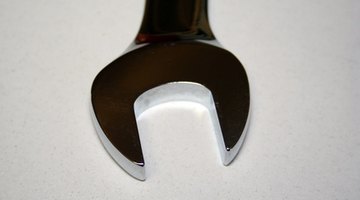How do I Fix Stanley Pocket Door Hardware?
Pocket doors may seem complicated due to all the hidden moving parts. While slightly more complicated than surface mount, swinging doors, they are much less complex than you may think. The main parts of the mechanism are two small rollers with four wheels each and a square track, with a wide, open slot in the bottom. Most problems require simple adjustment. Unless the door has been abused badly, the worst case scenario is the occasional need to reattach the wheel carriages.

-
Run the door back and forth a few times to determine what the issue is. If the door is not closing evenly, with one side higher than the other, the heights of the carriages need adjusting. If the door is having trouble sliding, one or both of the carriages may be off the track, or may have come loose from the top of the door. If the door seems wobbly, the track above is loose and needs tightening.
-
Center the door in the opening and tilt the bottom of it out toward you. Lift up on the top of the door to release the wheels from the track. This lifts the wheels off the track, and keeping the bottom tilted far enough out will allow them to drop away so that the door is free of the track. Set it down gently.
-
Locate the carriages on the top of the door and examine them. Grasp each carriage and shift it from side to side. If it appears loose at all, check to be sure the screws are all in place. Add screws, or tighten existing screws if needed. Replace hangers with severely worn or broken wheels with the same type and size. Compare new parts to the old for a proper fit. Use the provided screws to install new hardware.
-
Remove screws from carriages that are badly loose, or missing screws. Reposition the carriage slightly on the door top and drive the screws back through the holes in the carriage mounting bracket with a cordless drill, into the top of the door. Secure the screws and replace any missing screws with the same length and thickness as the original. Locate the carriages on the top of the door and examine them. Grasp each carriage and shift it side to side if it appears loose at all. Check to be sure the screws are all in place. Add screws, or tighten existing screws if needed. Replace hangers with severely worn or broken wheels with the same type and size. Compare new parts to the old for a proper fit. Use the provided screws to install new hardware.
-
Adjust the height of the door, if the door is riding crooked. There are two types of adjustment. Some doors have wheels on one side of the carriage, also known as a hanger. For this type of hanger, twist the wheel portion counterclockwise to lower the door and clockwise to raise it. For hangers with four wheels, turn the adjustment nut located in the center, under the wheels, with an open-ended wrench. Adjust both hangers to the tightest -- or highest -- setting. Turn back from this setting two full turns on both hangers.
-
Use a flashlight to examine the overhead track, inside the door frame. If it appears loose, add 1 5/8-inch, treated deck screws through the holes in the track hardware into the wooden header above. Tighten any loose screws. Run your hand down through the track with a clean rag to remove any dust or debris that may be causing issues. Check the stops at both ends of the track to make sure they are secure and tighten any loose screws.
-
Replace the door on the track by inserting the top into the opening with the bottom tilted out toward you, as you would for removal. Lift the hangers up past the track, tilt the bottom of the door down and lower the door into position. Test it and remove it for final adjustment, if needed.
References
Writer Bio
Mark Morris started writing professionally in 1995. He has published a novel and stage plays with SEEDS studio. Morris specializes in many topics and has 15 years of professional carpentry experience. He is a voice, acting and film teacher. He also teaches stage craft and lectures on playwriting for Oklahoma Christian University.
Photo Credits
- Wrench image by hugy from Fotolia.com
More Articles



